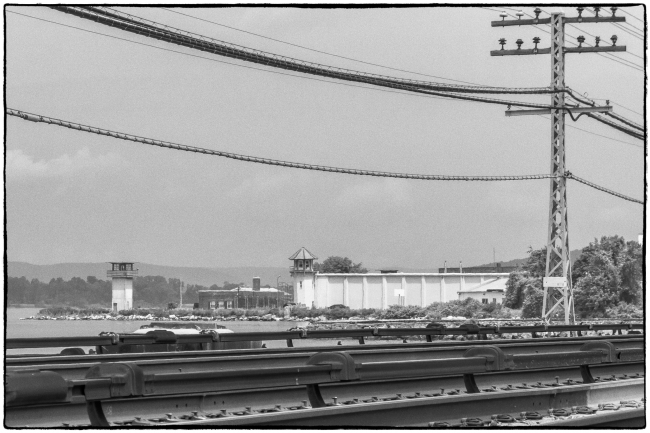Seen from down by the Hudson Line railroad tracks in Ossining, NY. Looking at this picture closely you can see that what should be vertical lines are, in fact, wavy. It was a very hot day so I suppose that this effect is some kind of heat haze.
According to Wikipedia:
Sing Sing Correctional Facility is a maximum security prison operated by the New York State Department of Corrections and Community Supervision in the village of Ossining, in the U.S. state of New York. It is located about 30 miles (50 km) north of New York City on the east bank of the Hudson River.
In 1970, the name of the facility was changed to “Ossining Correctional Facility” but, in 1985, it reverted to its original name. “Sing Sing” was derived from the name of a Native American Nation, “Sinck Sinck” (or “Sint Sinck”), from whom the land was purchased in 1685.
Sing Sing prison confines about 1,700 prisoners. There are plans to convert the original 1825 cell block into a time specific museum.
The prison property is bisected by the Metro-North Railroad’s four-track Hudson Line.
…
Sing Sing was the third prison built by New York State. The first prison, Newgate Prison, was built in 1797 in Greenwich Village and a second one in 1816 called Auburn State Prison.
In 1824, the New York Legislature gave Elam Lynds, warden of Auburn Prison and a former Army captain, the task of constructing a new, more modern prison. Lynds spent months researching possible locations for the prison, considering Staten Island, The Bronx, and Silver Mine Farm, an area in the town of Mount Pleasant, located on the banks of the Hudson River.
By May, Lynds had finally decided to build a prison on Mount Pleasant, near (and thus named after) a small village in Westchester County named Sing Sing, whose name came from the Native American words “Sinck Sinck” which translates to “stone upon stone”. The legislature appropriated $20,100 to purchase the 130-acre (0.53 km2) site, and the project received the official stamp of approval. Lynds hand-selected 100 inmates from the Auburn prison for transfer and had them transported by barge via the Erie Canal and down the Hudson River to freighters. On their arrival on May 14, the site was “without a place to receive them or a wall to enclose them”; “temporary barracks, a cook house, carpenter and blacksmith’s shops” were rushed to completion.
When it was opened in 1826, Sing Sing was considered a model prison, because it turned a profit for the state, and by October 1828, was finally completed. Lynds employed the Auburn system, which imposed absolute silence on the prisoners; the system was enforced by whipping and other brutal punishments.
Thomas Mott Osborne’s tenure as warden of Sing Sing prison was brief but dramatic. Osborne arrived in 1914 with a reputation as a radical prison reformer. His report of a week-long incognito stay inside New York’s Auburn Prison indicted traditional prison administration in merciless detail.
Prisoners who had bribed officers and intimidated other inmates lost their privileges under Osborne’s regime. One of them conspired with powerful political allies to destroy Osborne’s reputation, even succeeding in getting him indicted for a variety of crimes and maladministration. After Osborne triumphed in court, his return to Sing Sing was a cause for wild celebration by the inmates.
Another notable warden was Lewis Lawes. He was offered the position of warden in 1919, accepted in January 1920, and remained for 20 years as Sing Sing’s warden. While warden, Lawes brought about reforms and turned what was described as an “old hellhole” into a modern prison with sports teams, educational programs, new methods of discipline and more. Several new buildings were also constructed during the years Lawes was warden. Lawes retired in 1941 after 21 years as warden and died six years later.
In 1943, the old cellblock was finally closed and the metal bars and doors were donated to the war effort.
In 1989, the institution was accredited for the first time by the American Correctional Association, which established a set of national standards by which it judged every correctional facility.
Today, Sing Sing houses more than 2,000 inmates, with about 1,000 people working there and 5,000 visitors per month. The original 1825 cellblock is no longer used and in 2002 plans were announced to turn this into a museum. In April 2011 there were talks of closing the prison in favor of real estate.

